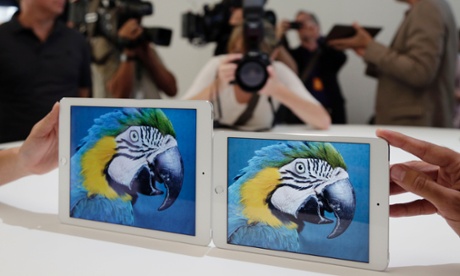
Apple’s new 4G-capable iPad Air 2 has a software-based sim card, removing the need for the small white plastic card that mobile phone operators use to control access to their services.
The new Apple sim in the iPad Air 2 means users in the US or UK do not need to get a sim card from a mobile phone providers, but can sign up directly for services from the device - and use the same sim in different countries with different providers.
“The Apple sim gives you the flexibility to choose from a variety of short-term plans from selected carriers in the US and UK right there on your iPad,” wrote Apple on its site for the iPad Air 2.
The move is a step closer to an entirely software-based sim for any country, which would give device buyers huge freedom in choosing their mobile supplier. The sim provides a subscriber’s unique ID and carries out the encrypted authentication to the network of that ID.
In the US, most phones are sold “locked” to a specific network, thus tying the customer to the carrier even if they want to end their contract early. Despite moves by the US Congress to end phone locking, it is still prevalent - and keeps phone tariffs and prices high. Moving to a software-based sim could mean phone locking is easier to stop.
EE, Sprint, T-mobile and AT&T on-board
Owners of the new iPad Air 2 model with the built-in mobile phone connection can take out short term data plans with different mobile phone providers when needed, meaning that a long contract is not necessary.
Presently only a few mobile phone providers are participating in the new technology, including EE in the UK, Sprint, T-mobile and AT&T in the US.
“The ‘Apple SIM’ is huge news. Shows the strength of Apple’s hand with carriers - no other manufacturer could have done that,” said Ben Wood, chief of research for CCS Insight.
The new sim technology, which sits in the same slot as a regular nano-sim and can be swapped out, will allow travellers to use a local mobile phone network for mobile broadband without having to pre-order a new sim or purchase one in a shop on arrival, switching networks with settings on the iPad.
Mobile phones using Code Division Multiple Access (CDMA)-based networks in the US have had a similar system for years. But users have been unable to switch networks without the mobile phone provider issuing new software to the phone, normally for a fee. UK mobile phone networks use the rival Global System for Mobile communications (GSM) standard.
The new technology could enable greater freedom in the mobile phone market by allowing customers to switch mobile phone networks on-the-fly, if and when a network provides better service or at lower cost.
Having appeared in the iPad Air 2, the technology could next appear in 2015’s update to the iPhone line - and perhaps in future versions of the Apple Watch, as it would not need a slot for a physical sim.
“Apple’s foray with ‘soft SIM’ in cellular iPads depicts the leverage and unprecedented power it has over carriers,” said Neil Shah, a mobile industry analyst with the analysis company Counterpoint Research. “Bringing soft sim to iPhone is not going to be as easy at global scale, nevertheless very important step to get it into iPads.”


0 comments:
Post a Comment